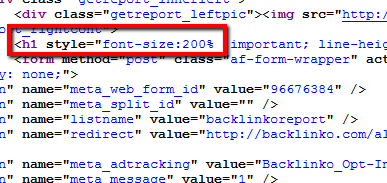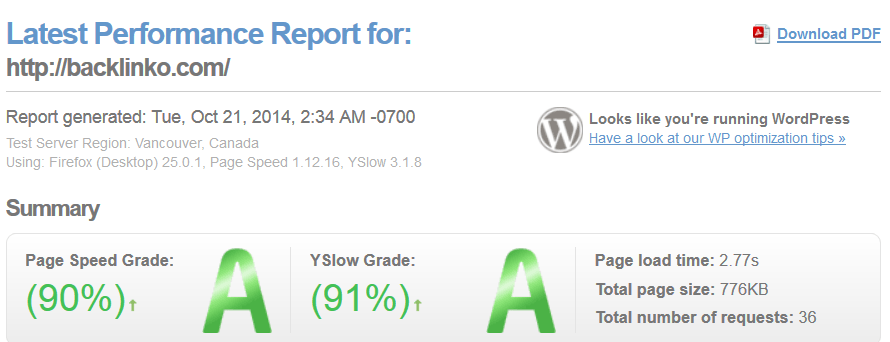On-page SEO, What You Should Know About It
Published on March 16 2016
When it comes to on-page SEO, I’m sure you’ve heard enough about meta tags and keyword density for one lifetime.
If you’re looking for some practical strategies that you can use on your site today, then you’ll love this infographic.
It’s a simple checklist that will bring in more search engine traffic from every piece of content that you publish:
1. Leverage SEO-Friendly Permalink URLs
You want your page’s URL to be short and keyword rich. Avoid ugly URLs, like backlinko.com/p=123 or long URLs like: backlinko.com/on-page-seo-is-so-amazing-omg-its-the-best.
Google has stated that the first 3-5 words in a URL are given more weight.
"I think that keyword-rich URLs are getting less and less important as Google gets better at figuring out relevancy using things like Hummingbird. But they still bold keywords in a URL in the SERPS", said Brian.
Which makes it clear that keyword-rich URLs still carry some weight. Also, I’ve been experimenting with including ONLY my target keyword as the URL. It seems to make a small but significant difference.
2. Goal=Start Title With Keyword
Your title tag is the most important on-page SEO factor. You also want to pay attention to where you place your keywords in your title.
In general, the closer the keyword is to the beginning of the title tag, the more weight it has with search engines.
"You don’t always need to start your title with your target keyword. But if there’s a keyword that you’re gunning for, make sure to put it towards the beginning", said Brian.
3. Dazzle with Multimedia
Text can only take your content so far. Engaging images, videos and diagrams can reduce bounce rate and increase time on site: two critical user interaction ranking factors.
"You probably notice that I use a lot of images, diagrams, and screenshots here at Backlinko. That’s because I firmly believe that it makes my content straight up better.
But it has a nice SEO benefit to boot: multimedia helps you boost those user-interaction signals that Google has been paying more attention to. And it increases the perceived value of your content: which means that people are more likely to link to it", said Brian.
4. Use Outbound Links
This is an easy, white hat SEO strategy to get more traffic. Outbound links to related pages is a relevancy signal that helps Google figure out your page’s topic. It also shows Google that your page is a hub of quality info.
"Not linking out might be the #1 on-page SEO mistake that I see people make. I usually link out 2-4x per 1000 words. That’s a good rule of thumb for most sites.
Keep in mind that the sites you link out to reflect on you. So make sure to link out to authority sites whenever possible", said Brian.
5. Drop Keyword in First 100 Words
Your keyword should appear in the first 100-150 words of the article.
"This is something that you probably do naturally.
But a lot of people start their posts off with a long, meandering intro…and use their keyword for the first time in middle of the post. It’s better to drop your keyword somewhere in the first 100 words or so. That helps Google understand what your page is all about", said Brian.
6. Wrap Your Title in an H1 Tag
The H1 tag is your “headline tag”. Most CMS’s (likeWordPress) automatically add the H1 tag to your blog post title. If that’s the case, you’re all set. But some themes override this setting. Check your site’s code to make sure your title gets the H1 love it deserves.
"I used to just assume that WordPress hooked up my post titles with H1 tags…until I actually looked at my site’s code. Then I realized that some WordPress themes sometimes use H1 tags to increase text size. As an example, my email opt-in area at the end of posts used to use an H1 tag:
It’s worth checking out your site’s code to make sure you only have one H1 tag per page. That H1 tag should contain your target keyword", said Brian.
7. Nail Loading Speed
Google has stated on the record that page loading speed is an important SEO ranking signal. You can boost your site speed by using a CDN, compressing images, and switching to faster hosting.
Make sure it doesn’t take more than 4 seconds for your page to load: MunchWeb found that 75% of users wouldn’t re-visit a site that took longer than 4 seconds to load.
You can easily check your site’s loading speed usingGTMetrix.com:
"CDNs and cache plugins are nice, but the #1 thing you can do to make your site faster is invest in premium hosting. Hostgator and Bluehost are decent for the money you’re paying. But they don’t hook you up with serious speed.
I’ve literally dropped loading times from 6 seconds to less than 2 seconds by switching from a $5 shared hosting plan to a top-notch host (I use Synthesis Hosting here at Backlinko). From a conversion and SEO standpoint, the ROI of premium hosting can’t be beat", said Brian.
8. Add Modifiers To Your Title
Adding modifiers like “2014”, “best”, “guide”, and “review” can help you rank for long tail versions of your target keyword.
"This is a great trick to wrangle in those super long tail keywords.
Notice that I made the title of this post nice and long: “On-Page SEO: Anatomy of a Perfectly Optimized Page”.
These modifiers aren’t targeting any particular long tail keyword. But that title will bring in a few more visitors every day than if I simply used “On Page SEO”, said Brian.
9. Use Social Sharing Buttons
Social signals may not play a direct role in ranking your site. But social shares generate more eyeballs on your content. And the more eyeballs you get, the more likely someone is to link. So don’t be shy about placing social sharing buttons prominently on your site.
In fact, a study by BrightEdge found that prominent social sharing buttons can increase social sharing by 700%.
"Social signals aren’t an important part of the Google algorithm (yet). But social shares on sites like Facebook, Twitter and Google+ may give you a slight direct and indirect boost", said Brian.
10. Post Long Content
The SEO adage “length is strength” was supported by a SERPIQ.com industry study which found that longer content tends to rank significantly higher on Google’s first page.
Aim for at least 2000-words when targeting competitive keywords.
As a rule, I make sure all of my articles have at least 1000-words of meaty, useful content.
Longer content helps you rank better for your target keyword and brings in more long tail traffic…a win-win!““, said Brian.
11. Slash Bounce Rate
A bounce — when a visitor quickly leaves your site — might be used by Google to gauge a page’s quality. After all, if someone finds your site from Google and quickly clicks away, how good could your site be?
"Bounce rate isn’t the end-all-be-all of user experience metrics…but it matters. Adding internal links to the beginning of your content is one the easiest and most effective ways to decrease your bounce rate and improve time on site.
I think when people first get to a page they’re more “click happy” then when they’re deeper in an article. That’s why internal links at the beginning of your articles tend to get clicked more often…slashing bounce rate significantly", said Brian.
12. Sprinkle LSI Keywords
LSI keywords are synonyms that Google uses to determine a page’s relevancy (and possibly quality).
I don’t go nuts about LSI because I usually write REALLY long content.
Long content increases the odds that you’ll naturally include LSI keywords in your content.
If you want to make 100% sure that you’re using LSI keywords, search for your keyword in Google and scroll down to the “Searches Related to…” area at the bottom of the page…
…And toss one or two of them into your post", said Brian.
Here are a few more important on-page SEO factors that I didn’t have room to include in the infographic:
Quality Content: I know that you’re sick and tired of hearing about “quality content”.
Even though search engines have no direct way of determining quality, they have plenty of indirectmethods, especially user-experience metrics like:
- Repeat visitors
- Chrome bookmarks
- Time on site
- Dwell time (more on that next)
In other words, great content definitely won’t hurt you. So there’s no reason NOT to publish awesome stuff.
Dwell Time: Bounce rate is important…but it’s not the end-all-be-all of user experience signals.
Why?
Because Google also uses “short clicks” vs. “long clicks” (also known as dwell time). Dwell time simply measures how long a searcher stays on your page before hitting the back button.
If someone hits their back button immediately after landing on your page, it’s a sign of a low quality page.
You can increase your average dwell time by writing long, engaging content that keeps people reading.
That way — even if they bounce back to the search results — you at least have a “long click”. That long click shows Google that you gave them something of value while they were there.
Internal Links: Internal linking is SO money. If you want to see a great example of how to internal link on your site, check out Wikipedia.
They add keyword-rich internal links to every entry:
Obviously, they can get away with 50+ internal links per page because they’re Wikipedia. I recommend a simpler (and safer) approach: link to 2-5 of your older posts whenever you publish a new one.
H2 and H3 Tags: I don’t think H2 and H3 tags are a big deal. But you should include your target keyword at least once in an H2 or H3 subheading. This also has the added bonus of making your content easier to read.
Image Optimization: I’ve found that traffic from image search to be pretty worthless (high bounce rate, low conversions etc.). That being said, I’ll take any visitor I can get. That’s why I always optimize each image around a keyword.
Make sure the file name includes your target keyword (for example, on_page_SEO.jpg) and that you include your target keyword as part of your image Alt Text:
Another reason to optimize your images for SEO: it gives search engines yet another clue of what your page is about…which helps it rank in organic search.
When Google sees images with alt text “blue widgets”, “green widgets” etc., it tells them: “this page is about widgets”.
I made a free on-page SEO checklist for you that will help you put these strategies into action for your site.
It outlines — step-by-step — exactly how to use the techniques that I talked about in this post…including 2 strategies that I didn’t include in the infographic.
Article Source: On-Page SEO: Anatomy of a Perfectly Optimized Page

/https%3A%2F%2Fassets.over-blog.com%2Ft%2Ftwentyeleven%2Fimages%2Fpine-cone.jpg)








